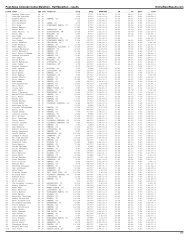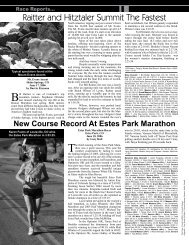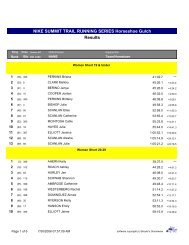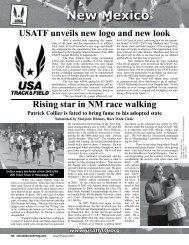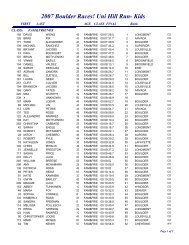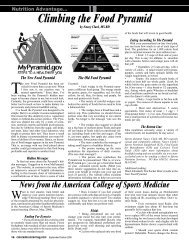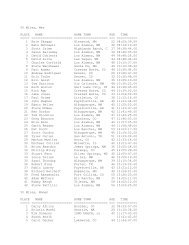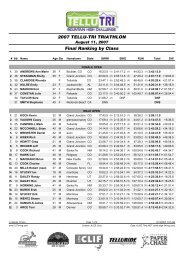by Jessica Griffiths - Colorado Runner
by Jessica Griffiths - Colorado Runner
by Jessica Griffiths - Colorado Runner
Create successful ePaper yourself
Turn your PDF publications into a flip-book with our unique Google optimized e-Paper software.
Hit The Dirt...<br />
sponsored <strong>by</strong><br />
Paint Mines<br />
<strong>by</strong> <strong>Jessica</strong> <strong>Griffiths</strong>
A<br />
run through the Paint Mines is a journey in time. Archaeologists claim that prehistoric people<br />
began living on the rolling prairie at the Paint Mines 9,000 years ago. Native Americans are<br />
known to have taken the colorful clays to produce pottery and ceremonial paint. The park is off<br />
the beaten path, but the views of red hoodoos and orange sandstone spires are worth the drive.<br />
Derek <strong>Griffiths</strong> / <strong>Colorado</strong> <strong>Runner</strong><br />
<strong>Runner</strong>s will immediately notice an unyielding wind<br />
on the quiet grassland. The park encompasses approximately<br />
750 acres and includes four miles of trails. The trails include<br />
two loops, which can be combined to make one large loop.<br />
Along the route, mule deer, coyote, red fox and pronghorn<br />
antelope can sometimes be seen. Short-horned lizards may<br />
scurry <strong>by</strong> your feet, while <strong>Colorado</strong>’s state bird, the Lark<br />
Bunting, may serenade you on your run.<br />
The trail is well marked, but you may want to take a brochure<br />
with you as it contains some very interesting information on the landscape<br />
that you will be running through. Begin your run on the wide, dirt trail<br />
that starts at the parking lot. Continue straight at the first junction. The<br />
trail is very hilly, so it will test your fitness. There is an elevation gain of<br />
560 feet and a high point of 6,759 feet. After about one half mile, make<br />
a sharp right at the sign onto the sandy trail and follow this to a four way<br />
crossing. Turn left to continue, but if you need to cut your run short, you<br />
can turn right and travel back to the parking lot. This trail travels uphill<br />
for 1.3 miles before approaching the next intersection. Continue to the<br />
right and run down the steep hill to another sandy trail. At this junction,<br />
you can turn left and run out and back if you want to add another 0.4 mile<br />
onto your run, or you can continue the loop <strong>by</strong> turning right. These sandy<br />
trails are narrow and have very sharp turns, so be ready for them. At the<br />
next junction, turn left and run up the steep hill to a bench. Once you pass<br />
this bench, it is all downhill to the finish. You will pass six different informational<br />
signs along the path that explain more about the history of the<br />
region.<br />
The Paint Mines are named for their brightly colored clays. The<br />
bands tinged with red, orange, yellow, purple and gray hues are caused <strong>by</strong><br />
oxidized iron compounds. When the outcrops erode, a hard capstone allows<br />
towers of clay to be preserved underneath, creating the spires called<br />
hoodoos.<br />
The Paint Mines Interpretive Park is located in northeastern El<br />
Paso County near Calhan. To get there, drive Highway 24 east from <strong>Colorado</strong><br />
Springs to Calhan. Turn south on Yoder Road/Calhan Highway. Turn<br />
east on Paint Mines Road and look for the designated parking area.<br />
The park is open from dawn until dusk. Pets, horses and bicycles<br />
are prohibited. The Paint Mines are considered significant in the<br />
prehistory of the region and the area is listed as an Archaeological District<br />
in the National Register of Historic Places. The removal of any rocks,<br />
plants, or historic artifacts is prohibited. A restroom facility is on site.<br />
A Historic Timeline<br />
Paleoindian Stage 7000 - 5500 B.C.<br />
The earliest people to live in the Paint Mines are known as the Paleoindians.<br />
They were likely the descendants of the first Americans<br />
who migrated over the Bering Land Bridge from northeastern Asia.<br />
They survived <strong>by</strong> hunting large game, such as mammoth, caribou<br />
and bison.<br />
Archaic Stage 5500 B.C. – A.D. 100<br />
The Archaic Stage was known for stone darts. The Archaic sites feature<br />
grinding stones that were used for processing plant material for<br />
food. For survival, the Archaic people relied on game animals like<br />
deer and pronghorn antelope and gathered plant foods.<br />
Ceramic Stage A.D. 100 – 1450<br />
The Ceramic Stage was trumpeted with the appearance of pottery,<br />
the bow and arrow, and a greater dependence on plants, such as corn<br />
and squash.<br />
Protohistoric Period and European Contact A.D. 1450 – 1900s<br />
The Protohistoric Period signaled the end of the prehistoric era. The<br />
people were hunter-gatherers who pursued a more nomadic lifestyle<br />
with the introduction of the horse. Euro-American settlers moved<br />
into the area in the 1800s.<br />
Courtesy El Paso County Parks<br />
November/December 2006 coloradorunnermag.com 45




